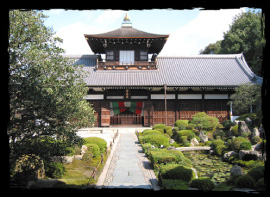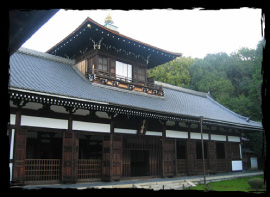 |
 |
A mysterious single garden composed of two styles |
 |
| |
Going over the Tsutenkyo Bridge, surrounded by a sea of colorful autumn leaves, and down the corridor, there is the Fumon-in Temple to the southwest of the Kaisando Hall, where it is said that the monk Enni once lived. All of these buildings are designated as important cultural properties.
If you go through the front gate to the temple, and up the approach road to look at the Kaisando Hall, your eyes will go immediately to the eaves of this many-storied building. Called the Dennekaku, this structure ranks as one of the most famous "five temple buildings of Kyoto," along with the Kinkaku-ji Temple and the Hiunkaku structure at Nishi Hongan-ji Temple.
In addition, the garden on both sides of the approach road at the Jyorakuan draws the attention of everyone who visits and creates a special atmosphere. On the east side of the approach road, the beautiful hill in the landscape garden is constructed in the "mountain, water and hillside field landscape style" and there is a turtle mound and a dry waterfall in the middle of the pond. On the opposite west side, the garden is done in the karesansui rock garden style, and the checkered pattern in the dry sand represents waves, while stones take the place of the usual mounds for cranes and turtles.
The simple karesansui rock garden style, so appropriate for a Zen temple and the "mountain, water and hillside field landscape style" blend in harmony even though they are so opposite, forming a single garden composed of two styles. The view from the Kaizando Hall and the Fumon-in Temple will surely convince you of its superb harmony. |
| |
|
|
 |
 |
| Kaizando Hall |
|
 |
 |
Kaizando Hall seen
from the Fumon-in Temple |
|
|

